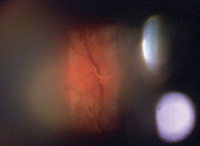 For years, color testing was used to determine the presence of various color vision deficiencies (CVDs). But, in the future––as technology improves and subtle anatomic changes become increasingly more measurable––color vision testing could be employed to help detect potential glaucoma and retinal disease.
For years, color testing was used to determine the presence of various color vision deficiencies (CVDs). But, in the future––as technology improves and subtle anatomic changes become increasingly more measurable––color vision testing could be employed to help detect potential glaucoma and retinal disease.
Color Vision Testing
Traditionally, Ishihara color testing was the most commonly used metric in the evaluation of color perception. Dr. Shinobu Ishihara at the University of Tokyo first designed the test in 1917. Ishihara testing includes the use of color plates with various dots to determine the presence and type of CVD.
In addition to Ishihara plates, there are several other useful CVD tests. Hardy-Rand-Rittler plates can be helpful in uncovering tritan deficiencies associated with macular pathologies. The Farnsworth arrangement test may assist in the assessment of acquired CVD. Finally the Nagel anomaloscope may help to more specifically diagnose and grade color vision anomalies.
Unfortunately, most of these CVD tests are subject to operator error, including lighting differences, plate fading, inability to grade condition severity and poor reproducibility.1
Congenital and Acquired CVDs
Because genetic CVDs typically are caused by X-linked mutations, men are much more likely to have color vision anomalies than women.2 Men only have one X chromosome (XY), while women have two (XX). So, in females, a mutation on one X chromosome can be overridden by the other normal X chromosome.3

This patient presented with reduced color vision caused by optic nerve damage secondary to papilledema.
Color vision anomalies are surprisingly common, with green deficiency (deuteranopia) affecting approximately 8% of the male population with Northern European ancestry.4 Another form of color deficiency is protanopia, which affects only 1% of US males.2,3 In protanopia, the red retinal receptors are weak or absent, which causes all red colors to appear black. Tritanopia, an even rarer form of CVD, is defined as the absence or deficiency of blue retinal receptors.3 This is the only form of CVD that isn’t X-linked, but rather is related to a pigment gene mutation located on chromosome 7.3
The primary difference between congenital and acquired CVDs is that genetic deficiencies present bilaterally at birth. Acquired CVDs, on the other hand, can be unilateral, asymmetric or even transient. Furthermore, the prevalence of acquired CVD is nearly equal between males and females.5
It is interesting to note that most genetic CVDs often are deutan or protan in nature, but acquired CVDs typically are tritan.
Not Just for CVD Detection
Color vision testing actually may help eye care providers uncover a host of other conditions, including glaucoma, optic neuropathy and Duchenne muscular dystrophy.
Researchers have estimated that as many as 30% to 50% of patients with primary open-angle glaucoma (POAG) have tritan deficiencies, 20% to 30% have general loss of color discrimination and 5% have deuteran deficiencies.6 One study indicated that loss of color hue perception is much higher in patients with glaucoma, even when adjusting for an aging retina or lenticular changes.6 In addition to POAG, patients with acute angle-closure glaucoma are more likely to exhibit tritan deficiencies than those with no history of glaucoma.6
Other ocular conditions that affect color vision testing include Leber’s congenital optic neuropathy, arteritic anterior ischemic optic neuropathy and nonarteritic anterior ischemic optic neuropathy.7-9 Further, patients with optic neuritis typically experience reduced color vision (particularly red desaturation) in the affected eye.10-12
Even the diagnosis of certain systemic diseases can be guided by color vision testing. For example, 66% of all patients with Duchenne muscular dystrophy exhibit red-green color deficiencies.13
Keep in mind that color testing results can be affected by more than a dozen medications, including digoxin, ethambutol, clioquinol, isoniazid, amiodarone, linezolid, methotrexate, sildenafil, oxymetazoline, infliximab, cisplatin or tamoxifen.14-17 So, be sure to question patients about prescription drug use prior to color vision testing.
Color vision testing has an important place in primary-care disease diagnosis. When using color testing to screen for potential optic nerve or retinal disease, it is essential to test pupillary function, visual acuity and visual fields as well. Once a full assessment is made, you may determine the most appropriate management strategy.
1. Hovis JK, Ramaswamy S. The effect of test distance on the CN lantern results. Vis Neurosci. 2006 May-Aug;23(3-4):675-9.
2. Deeb SS. Molecular genetics of color vision deficiencies. Clin Exp Optom. 2004 Jul;87(4-5):224-9.
3. Drummond-Borg M, Deeb S, Motulsky AG, et al. Molecular basis of abnormal red-green color vision: a family with three types of color vision defects. Am J Hum Genet. 1988 Nov;43(5):675-83.
4. Albrecht M. Color blindness. Nat Methods. 2010 Oct;7(10): 775.
5. Pinckers A, Marre M. Basic phenomena in acquired colour vision deficiency. Doc Ophthalmol. 1983 May 1;55(3):251-71.
6. Sit AJ, Medeiros FA, Weinreb RN. Short-wavelength automated perimetry can predict glaucomatous standard visual field loss by ten years. Semin Ophthalmol. 2004 Sep-Dec;19(3-4):122-4.
7. Jung JJ, Baek SH, Kim US. Analysis of the causes of optic disc swelling. Korean J Ophthalmol. 2011 Feb;25(1):33-6.
8. Luneau K, Newman NJ, Biousse V. Ischemic optic neuropathies. Neurologist. 2008 Nov;14(6):341-54.
9. Hayreh SS. Anterior ischaemic optic neuropathy. Differentiation of arteritic from non-arteritic type and its management. Eye (Lond). 1990;4(Pt 1):25-41.
10. Hoorbakht H, Bagherkashi F. Optic neuritis, its differential diagnosis and management. Open Ophthalmol J. 2012;6:65-72.
11. Katz B. The dyschromatopsia of optic neuritis: a descriptive analysis of data from the optic neuritis treatment trial. Trans Am Ophthalmol Soc. 1995;93:685-708.
12. Dooley MC, Foroozan R. Optic neuritis. J Ophthalmic Vis Res. 2010 Jul;5(3):182-7.
13. Costa MF, Oliveira AG, Feitosa-Santana C, et al. Am J Hum Genet. Red-green color vision impairment in Duchenne muscular dystrophy. 2007 Jun;80(6):1064-75.
14. Novack GD. Curr Opin Ophthalmol. Ocular toxicology. 1995 Dec;6(6):108-12.
15. Cordell WH Retinal effects of 6 months of daily use of tadalafil or sildenafil. Arch Ophthalmol. 2009 Apr;127(4):367-73.
16. Ayuso Blanco T, Aliseda D, Ajuría I, et al. Inflammatory optic neuritis. An Sist Sanit Navar. 2009 May-Aug;32(2):249-63.
17. Eisner A, Luoh SW. Breast Cancer Medications and Vision: Effects of Treatments for Early-stage Disease Curr Eye Res. 2011 Oct;36(10):867-85.

